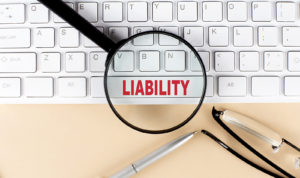 Unfortunately, companies bring defective products to the market all the time. Some of those products cause severe, catastrophic, and fatal injuries that impact people and their families for the rest of their lives. However, not all injuries related to the use or consumption of a product serve as grounds for a product liability claim. It’s in your best interest to consult an experienced product liability attorney to evaluate your claim and determine your eligibility to recover damages.
Unfortunately, companies bring defective products to the market all the time. Some of those products cause severe, catastrophic, and fatal injuries that impact people and their families for the rest of their lives. However, not all injuries related to the use or consumption of a product serve as grounds for a product liability claim. It’s in your best interest to consult an experienced product liability attorney to evaluate your claim and determine your eligibility to recover damages.
Until you have the chance to meet with an attorney, we provide some introductory information about the elements of a product liability claim.
A legitimate product liability claim has four elements:
- Injury or loss
- Product defect
- Causation
- Intended Use
Here is a broad overview of each element of a product liability claim.
Table of Contents
- Injury or Loss
- Product Defect
- Causation
- Intended Use
- Product Liability Claims Include Various Products
- Liability in Product Liability Claims
Injury or Loss
Anyone who wants to take legal action by bringing a lawsuit against a manufacturer or other party for a defective product must suffer an injury or some type of loss, so they have a claim for damages. Damages include economic and non-economic losses, which can be more challenging to prove. Various types of evidence serve as evidence of injury or loss, including medical records, police reports, and eyewitnesses.
Types of Injuries in Product Liability Lawsuits
A small cut or any other minor injury that only needs five minutes of first aid typically does not warrant a product liability claim. Death, catastrophic injuries that prevent work, and severe injuries that cause a permanent condition or leave permanent scars almost always give rise to a product liability claim.
Without a lawyer, you will not know if your injury provides grounds for a product liability claim. If you think you need a lawyer, you probably do. It doesn’t cost anything to consult with an attorney to find out if you have a viable claim.
The United States Consumer Product Safety Commission (CPSC)—a consumer watchdog agency—reports the following common defective product injuries, many of which lead to product liability claims:
- Deep cuts and wounds, especially those that leave permanent scars or cause significant soft tissue damage to muscles, ligaments, or tendons
- Burns from fires, explosions, and corrosive substances
- Amputation or crushed limbs
- Electrocution injuries and other injuries related to electricity
- Drowning
- Carbon monoxide poisoning
- Brain injuries
- Neck and back injuries
- Spinal cord injuries
- Terminal illness or permanent condition, typically a result of exposure to harmful substances, defective prescription drugs, or defective medical devices
An experienced product liability lawyer can discuss the details of your injuries and evaluate your case to see if you have a viable claim against the product manufacturer responsible for the defect that led to your injuries.
Recovering Losses in Product Liability Claims
If you, with the help of your experienced product liability lawyer, prove all the elements of your claim, you could recover various damages related to your injuries and associated losses.
Examples of damages commonly included in product liability claims include:
- Medical costs for treating your injuries, including ambulance service if applicable, emergency room treatment, doctor visits, diagnostic imaging, lab tests, prescription medication, surgery, aftercare, hospitalization, and transportation costs to and from the treating facility
- Estimated future medical treatment costs when a defective product causes a permanent condition that requires ongoing care or treatment
- Rehabilitation costs, including specialized treatment with physical therapists, occupational therapists, speech therapists, mental health professionals, and other specialists that help injured patients cope with the mental and physical aspects of their injuries
- Lost wages due to injury, hospitalization, and rehabilitation associated with use or exposure to a defective product
- Estimated lost wages when a defective product causes catastrophic injuries that prevent people from returning to their job or working in the future
- Emotional and physical pain and suffering
- Reduced quality of life
- Loss of consortium
- Scarring and disfigurement
- Punitive damages when the product liability case involves fraud or misrepresentation
If you have lost a loved one because of a defective product, you might be eligible to recover damages in a wrongful death liability lawsuit.
Examples of common damages in wrongful death lawsuits include compensation for:
- Medical bills paid by surviving family members
- Funeral expenses and cremation or burial costs
- Loss of companionship and support for surviving spouses
- Loss of parental guidance and support for surviving dependent children
Your lawyer can answer specific questions related to your claim and advise you on which damages apply to your situation.
Product Defect
Another major element of a product liability claim is a product defect. You need to prove the product was defective and that it is unreasonably dangerous to users and consumers to have a valid product liability claim. Product defects fall under three different categories:
Design Defects
Design defects occur during the conceptualization phase of a new product. Designers, engineers, and other stakeholders come up with an idea for a new product, whether it be a toy, a vehicle, an appliance, a medical device, or something else. Somewhere in the design, there is a flaw that makes the product unreasonably dangerous for use or consumption. Sometimes companies catch these flaws during production but oftentimes do not realize the design flaw until people suffer injuries.
Manufacturing Defects
Manufacturing defects occur during the production phase of a new or already existing product. A flaw gets introduced to the product during construction, assembly, or formulation, depending on the type of product. Human error and machine malfunctions play a large role in most manufacturing defects. Inaccurate inputs into sophisticated machinery can cause a manufacturing defect, and humans can cause damage to a product.
Other things that could lead to a manufacturing defect include poor packaging, subpar materials, and the wrong materials for a specific product. Quality control processes sometimes stop defective products from reaching the public, but this is not always the case.
Marketing Defects
Marketing defects, also called information defects, encompass a wide range of problems related to the information a manufacturer, distributor, or retailer provides to consumers about a product. First, manufacturers have a legal obligation to warn the public about any dangerous aspects of using or consuming their products.
Additionally, they must provide adequate instructions for the assembly and/or use of their products. The failure to warn or instruct consumers is among the most common information defects. However, companies can introduce marketing defects into a product by making false claims about the safety of a product.
Causation
Arguably the most contentious element of a product liability claim is causation. You must prove that the defective product caused your injury. If you cannot directly link a product’s defect to your injuries and losses, you might not have a valid product liability claim.
Sometimes causation is abundantly clear. Yet, many times proving the link between injuries and a product defect is not that easy. This is especially true with toxic chemical exposure and situations where the damages include the diagnosis of a permanent disease or condition, such as cancer. In this example of a defective product, a lawyer has to prove that a patient would not have developed or died from cancer if not for their exposure to a specific substance.
Proving the element of causation serves as the best reason for those injured by defective products to hire an experienced product liability lawyer. Prevailing in a claim is often the difference between a skilled lawyer and a poor one.
Knowledgeable product liability attorneys know how to apply the law to a case, but exceptional lawyers know how to identify the links between a defective product and injuries. They are also painfully aware of questionable tactics employed by large corporations, their legal teams, and their insurance companies to avoid paying out a claim.
Intended Use
The final key element of a product liability claim revolves around intended use. For your claim to be legitimate and valid, you must be able to prove that you were using the product as the manufacturer intended.
If an injury occurs while someone uses a product as a company intended, the company could be financially responsible for damages because they should have foreseen potential injuries, or they knew about potential injuries and did not take action. If someone is using a product in a different way than its intended use, a manufacturer or retailer has no way of predicting or foreseeing injury or death.
For example, consider a child who lets a friend ride on the handlebars of his bicycle. Handlebars are used for steering a bike not holding riders. If the handlebars broke and one or both children suffered injuries, it would be unlikely they would have a viable product liability claim against the manufacturer or another party for damages related to their injuries.
Product Liability Claims Include Various Products
Some people only think of prescription drugs, cars, and other items they commonly see in the news when they think of product liability claims. However, a consumer can have a claim against a wide range of defective products. The United States Consumer Product Safety Commission (CPSC) creates standards to protect consumers and conducts research into injuries and illnesses related to defective products.
Thousands of products have reported defects, so it’s impossible to list them all. However, the CPSC groups defective products into different categories.
They include:
- Infant nursery equipment like cribs, changing tables, mobiles, and more
- Toys
- Sports and recreation equipment
- Home communications and entertainment products
- Personal use items
- Household containers
- Garden and yard equipment
- Home workshop and home maintenance equipment
- Household appliances
- HVAC equipment
- Home furnishings, fixtures, and structures
- Construction materials
- Miscellaneous items like fireworks, gasoline, and elevators
Cars, trucks, and other motorized vehicles sometimes have defects or defective parts. The CPSC tracks scooters, mopeds, and other small motorized items. However, they do not gather data about defective automobiles, trucks, or boats. Motor vehicles can have many recall issues. The most common recent defective vehicle claims include defective airbags and defective tires.
Liability in Product Liability Claims

If you have all the elements that make a viable product liability claim and your lawyer believes they can prove each element, you might name one or more parties in a product liability lawsuit. Most people automatically assume the manufacturer is responsible for damages related to defective product injuries.
This is true in most cases, but anyone involved in designing, building, formulating, marketing, distributing, or selling a product could share liability with the manufacturer. Parties you might name in a product liability lawsuit include:
Manufacturers
Global businesses headquartered in the United States, as well as start-up companies that operate out of a home office or garage, can be liable for damages in a product liability lawsuit if their defective product harms someone. Additionally, companies that manufacture parts for motorized vehicles, heavy equipment, boats, and other large items might also share liability for damages in a product liability lawsuit.
Wholesalers and Distributors
Even though they play no part in designing, constructing, or formulating a product, wholesalers and distributors can be liable for damages in a product liability claim. Companies or individuals who knowingly sell a product with defects to other businesses, modify the product to make it defective or damage a product that causes a defect could be wholly liable if their actions directly led to the defect that caused injury or illness to other people.
Shippers
Some product manufacturers rely on third-party shippers to transport their products to the businesses or individuals that buy them. Shippers do not always handle packages with care. If their carelessness causes damage during a pick-up, transport, or delivery, that leads to a defect, the shipper could be responsible for damages if the defective product harms someone.
Retailers
Consumers who shop online, head to their favorite big-box retailer, or visit a local retailer expect the products they buy to be safe for their consumption or use. Retailers who knowingly sell defective products, make false claims about products, or provide questionable testimonials about a product’s use or safety, could be liable for damages if a customer (or patient in the case of defective pharmaceuticals) suffers injury or contracts an illness from use, exposure, or consumption.
If you have suffered injuries from a defective product, let an experienced product liability lawyer review the details of your case and advise you on the best course of action for your situation.
